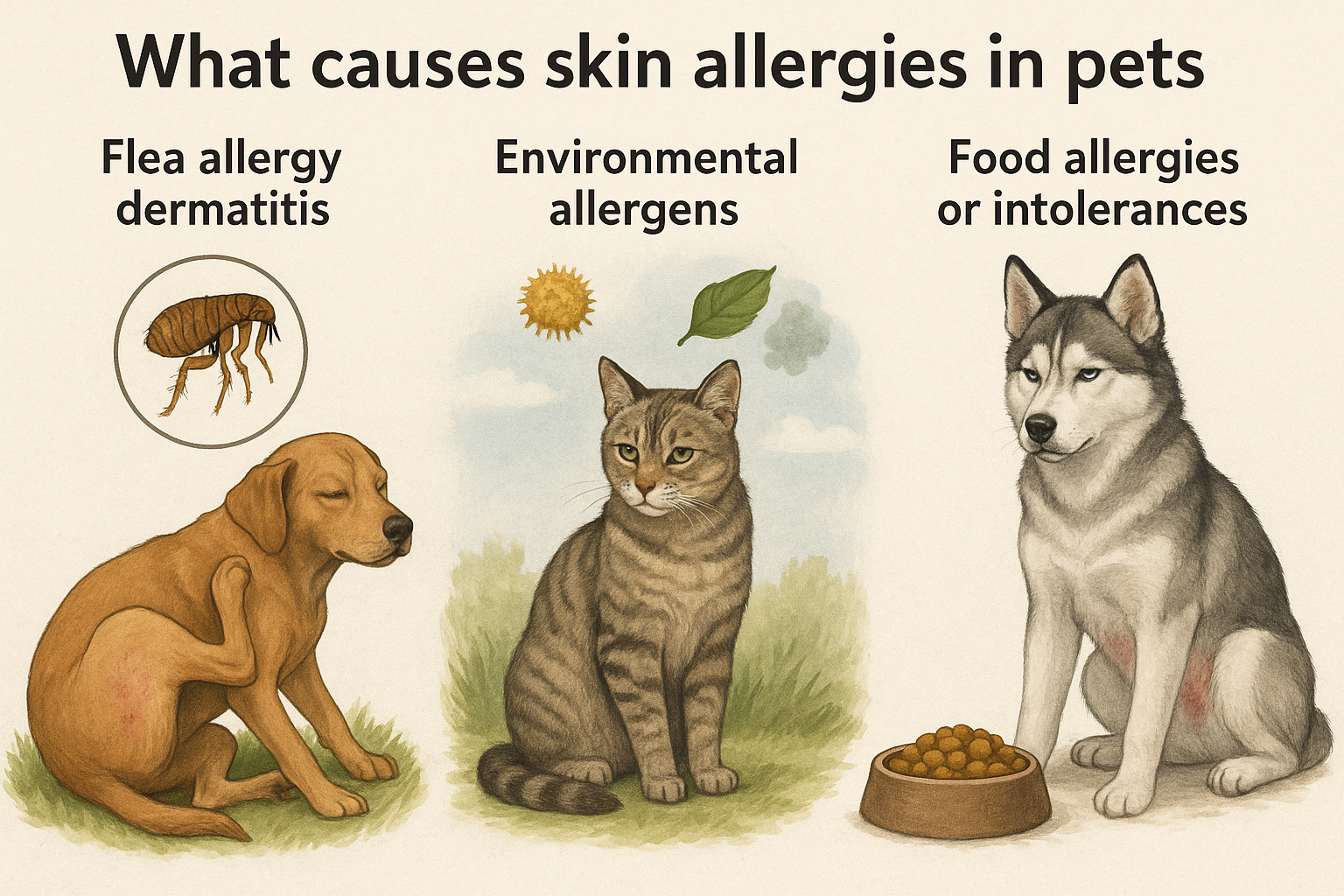All animals scratch, but when that behavior becomes obsessive, persistent, or leads to visible damage, it may be the result of an allergic response. Skin allergies are one of the most misunderstood and frequently misdiagnosed conditions in dogs and cats. What starts as occasional itching can turn into chronic discomfort, open wounds, and infections if not properly addressed.
These allergic reactions can stem from food, environmental triggers, or parasites. They often show up as dermatitis, hot spots, ear infections, or red, inflamed skin. For the animal, the symptoms are not just uncomfortable, they are distressing. For the owner, watching a pet suffer day after day without clear answers can feel just as painful.
Recognizing the cause and finding an effective path forward requires time, observation, and a willingness to adapt.
What causes skin allergies in pets
The causes of skin allergies fall into three main categories:
1. Flea allergy dermatitis
Even one flea bite can trigger a severe allergic response in sensitive pets. The protein in flea saliva causes inflammation, hair loss, and intense itching. This reaction often continues long after the fleas are gone.
2. Environmental allergens
These include pollen, mold, dust mites, and grass. Symptoms may be seasonal or year-round, depending on exposure. Pets can absorb these allergens through their skin or inhale them, leading to systemic immune reactions.
3. Food allergies or intolerances
Certain proteins in food, such as chicken, beef, or dairy, can trigger reactions. Contrary to popular belief, food-related skin allergies are not always immediate and may take time to appear. Digestive symptoms sometimes accompany the skin flare-ups.
Each case is unique. What works for one animal may not work for another. That is why a structured process of elimination and testing is often necessary.

Signs to look for
Some allergic reactions are easy to identify. Others are more subtle. Here are signs that may indicate your pet is experiencing a skin allergy:
- Persistent itching or licking
- Red or inflamed skin
- Hair loss or bald patches
- Scabs or open sores
- Chronic ear infections
- Head shaking or face rubbing
- Chewing paws or base of tail
- Strong, musty odor
These signs often come in cycles. You may see an improvement followed by a flare-up, which can be frustrating and confusing. It is important to remember that these behaviors are not just habits, they are attempts to relieve pain or discomfort.
Diagnostic process and treatment strategies
Diagnosing skin allergies involves ruling out causes one by one. This may include skin scrapings, blood tests, food trials, or intradermal testing. The process can take weeks or even months, especially when symptoms fluctuate.
Effective treatment depends on the underlying cause, but often includes:
Flea control
Whether or not fleas are visible, they must be ruled out. Year-round flea prevention is essential for allergic pets.
Anti-inflammatory support
Steroids, antihistamines, or other immune-modulating drugs may be used short-term to reduce inflammation and allow the skin to heal.
Topical relief
Shampoos, sprays, and creams that soothe skin and restore the barrier can reduce irritation. Look for products containing oatmeal, aloe, or antimicrobial agents.
Diet modification
An elimination diet under supervision may identify problem proteins. Novel protein diets or hydrolyzed diets are often effective for food-related issues.
Allergen avoidance
If pollen or dust is the trigger, keeping your home environment clean and using HEPA filters can reduce exposure. In some cases, immunotherapy may be considered.
Long-term management usually involves a combination of approaches, along with consistent monitoring and adaptation.

When care becomes about comfort
Most pets with skin allergies can be managed, but some cases become more complicated with time. Secondary infections, severe immune reactions, and drug resistance can arise. When a pet’s body no longer responds to treatments or when the quality of life begins to decline, owners are left with hard questions.
What happens when nothing works? When the treatments stop helping? When their suffering becomes constant?
These questions mark the boundary between chronic care and palliative support. They are emotionally charged, and they demand not just answers, but empathy.
Cryopreservation: preserving future possibilities
In situations where decline becomes irreversible, some people begin to explore long-term options that reach beyond today’s care limits. Cryopreservation is one such option. Available for both humans and animals, it involves stabilizing the body after legal death at ultra-low temperatures, with the goal of preserving biological structure until future technologies may make revival and treatment possible.
Cryopreservation is not a cure. It is not an escape from reality. It is a scientifically grounded process that offers people and their companions a chance to extend hope into a future where the limits of today no longer apply.
We know how emotionally complex a diagnosis can be, whether it involves months of ongoing management or an unexpected terminal turn. That is why we are here, not to make promises, but to offer clarity about what cryopreservation can provide and how it works, if and when you are ready to explore it.
About Tomorrow.bio
At Tomorrow.bio we are dedicated to advancing the science of cryopreservation with the goal of giving people a second chance at life As Europe’s leading human cryopreservation provider we focus on rapid high-quality standby, stabilization and storage of terminal patients preserving them until future technologies may allow revival and treatment.
Our mission is to make human cryopreservation a reliable and accessible option for everyone We believe that no life should end because current capabilities fall short.
Our vision is a future where death is optional where people have the freedom to choose long-term preservation in the face of terminal illness or fatal injury and to awaken when science has caught upInterested in learning more or becoming a member
📧 Contact us at hello@tomorrow.bio
🌐 Visit our website www.tomorrow.bio
🤝 Schedule a call with our team Book a consultation



